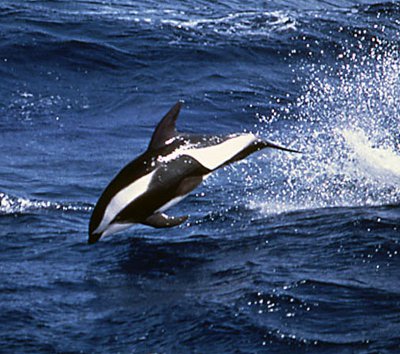Hourglass Dolphin
Category: Dolphin

Facts about Hourglass Dolphin, The Hourglass dolphin, sometimes called the sea cow, lives in the Antarctic Ocean. "Scientific name for Hourglass Dolphin is Lagenorhynchus Cruciger". The “Cruciger†means cross-bearing, though the wavy white and gray stripes on their sides more closely resemble an hourglass’ curves. The Hourglass Dolphin are mostly black, but they have two patches that run from the dorsal fin to the beak and another at the dorsal fin that reaches the tail. These two wide, light colored patches are connected by a thin white strip around the dorsal fin.
Hourglass dolphins are very rare, with specimens recovered from four strandings. The Hourglass Dolphin share the same ranges as the southern right whale dolphin, living in the waters around Antarctica and somewhat around the tip of South America.
Their exact numbers are unknown, but they are estimated at 100,000 Hourglass Dolphin. Because their numbers are unknown, hunting Hourglass dolphins is illegal.
Only a dozen members of the Hourglass Dolphin have been examined. Most information about the species comes from observation. The Hourglass Dolphin was first identified in 1824, whereas bottlenose dolphins were regularly mentioned by the Greeks three thousand years ago.
Hourglass dolphins are around five feet (1;53 meters) long but weigh over 250 pounds (113 kg). This means they are stouter and thicker than their tropical cousins, the bottlenose dolphins. This is probably an adaptation to the colder waters, where a thin body would lose too much body heat to the frigid ocean. The Hourglass Dolphin will ride in the bow of a ship like bottlenose dolphins.
Hourglass dolphins are carnivores, living off of fish, squid and any crustaceans they can catch. They live in small groups, with most observed groups consisting of fewer than ten dolphins. They have been seen feeding in large groups up to a hundred Hourglass dolphins. They will feed alongside pilot whales and fin whales.
It is assumed that Hourglass dolphins have a similar infancy as other sea-dwelling dolphins, with an infant nursing for a year to a year and a half before separating. Research on Hourglass dolphin specimens suggests a one year gestation period.
The only predators Hourglass dolphins face are killer whales, who will hunt them in packs. Since there is very little fishing in the Antarctic, Hourglass dolphins aren’t killed in tuna nets or by fisherman as their other cousins often are.

 Back To Category Dolphin
Back To Category Dolphin